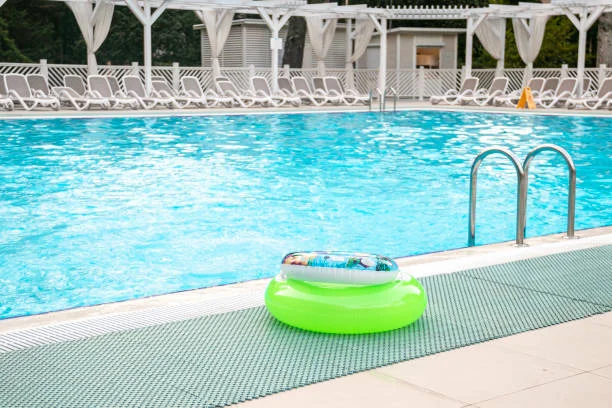Rubber pool decks are a solid choice for anyone who wants a surface that’s slip-resistant, gentle on bare feet, and easier on joints than concrete. But even though they’re tough and weather-friendly, they’re not something you can just ignore once installed.
Rubber holds up well against sun, splashes, and daily use, but it still benefits from occasional care. The good news is that maintaining it doesn’t involve any complicated tools or harsh chemicals. If you’ve been wondering how to maintain rubber pool deck surfaces without a lot of fuss, a few small habits go a long way.
If you’ve already looked into the decking pool with Safestep or have a rubber surface around your pool now, here’s how to keep it looking sharp and feeling safe.
There’s so much more to discover—browse our related posts!
1. Hose It Off Regularly—Don’t Let Gunk Sit
You’d be surprised how quickly debris builds up around a pool. Leaves, bits of food, spilled drinks, sunscreen—give it a few hot days and suddenly your surface feels grimy underfoot.
The easiest way to keep it clean? Hose it off every few days. A quick rinse with a yard hose will be adequate. No need for fancy settings or strong pressure. In fact, going too hard with a pressure washer can do more harm than good—especially if the surface is older.
Focus on corners and shaded areas where dirt tends to settle. After storms or heavy use, give it an extra rinse to clear anything that might’ve stuck. Rubber pool deck maintenance starts with the simple stuff, and this one’s easy to stay on top of.
2. Don’t Use Harsh Stuff on It
When it’s time to do a deeper clean, use mild soap and warm water. Dish soap works fine. If you need to scrub a little, go for a soft brush—not something too stiff. Scratching the surface is not the aim; lifting dirt is.
Avoid bleach, degreasers, or anything with strong solvents. They might get rid of a stain in the moment, but they’ll also wear down the rubber’s binder and color over time. That can lead to brittleness or discoloration—especially if it’s sunny where you live.
If you’re ever unsure about a cleaner, test it in a small hidden spot first. Or better yet, just stick to plain water and soap unless there’s a real mess to deal with.
3. Keep an Eye on Drainage
To keep a rubber deck in good shape, it needs to drain well. If water stays in one place for too long, it can cause mold, algae, or even slow damage to the ground.
Check to see where the water goes after a storm or a huge splash. If you see puddles that weren’t there before, it could signify that the ground has changed a little or that something underneath needs to be fixed.
Sometimes the fix is simple—sweeping away debris, unblocking a nearby drain, or gently brushing water off the surface. But if it keeps happening in the same area, it’s worth asking a professional to take a look.
4. Be Careful With Heavy or Sharp Objects
Rubber can endure kids running about, people walking on it, and even the occasional wrestling match by the pool. But pulling metal chairs or dropping heavy things on it? That’s a different story.
If you’re not careful, the surface can get dents, scratches, or tears.To avoid damage:
- Lift furniture instead of dragging it
- Put mats under the legs of tables and chairs to protect them.
- Keep tools and equipment off the deck while you’re not using them.
Also, watch out for rolling carts or wheeled coolers. Sand or gravel stuck in the wheels can grind into the rubber and leave marks that won’t come out easily.
Part of knowing how to maintain rubber pool deck areas is understanding how they can be damaged. Preventing harm is half the battle.
5. Know When It’s Time for a Touch-Up
Even the best materials wear over time. If your rubber deck is starting to lose its color, feel rough, or look patchy in high-traffic spots, that’s usually a sign it’s ready for some attention.
Most surfaces last a good five to eight years before they need a fresh coat or minor repair. If you’ve noticed:
- Color fading unevenly
- Loss of grip near steps or entrances
- Tiny cracks or edge peeling
The sooner you deal with it, the better. Small repairs now can prevent bigger ones later. Sometimes a recoat is all it takes to bring the surface back to life. It’s a key part of rubber pool deck maintenance that often gets overlooked until it’s too late.
A Few Final Habits That Help
- Sweep before rain is in the forecast. Dirt that dries into the surface is harder to clean.
- Encourage guests to eat away from the pool edge. Food oils are one of the few things rubber doesn’t love.
- Shade can help reduce fading, so if you’ve got an umbrella or pergola, use it.
These little things add up. You don’t need a maintenance calendar—just a few good habits and a quick visual check every so often
Wrapping Up
Rubber pool decking is easy to take care of, but like anything else outside, it does better with some maintenance. If you take care of it by keeping it clean, being kind with it, and looking for signs of wear, it will keep doing its job year after year.
SafeStep contains further information if you want to install a surface like this or want to know more about where it works best. Rubber isn’t just for pools; it’s also a good choice for covering sidewalks and other outdoor areas where durability and slip-resistance are important.
To explore all our latest posts in one place, be sure to visit the 2A Magazine.







